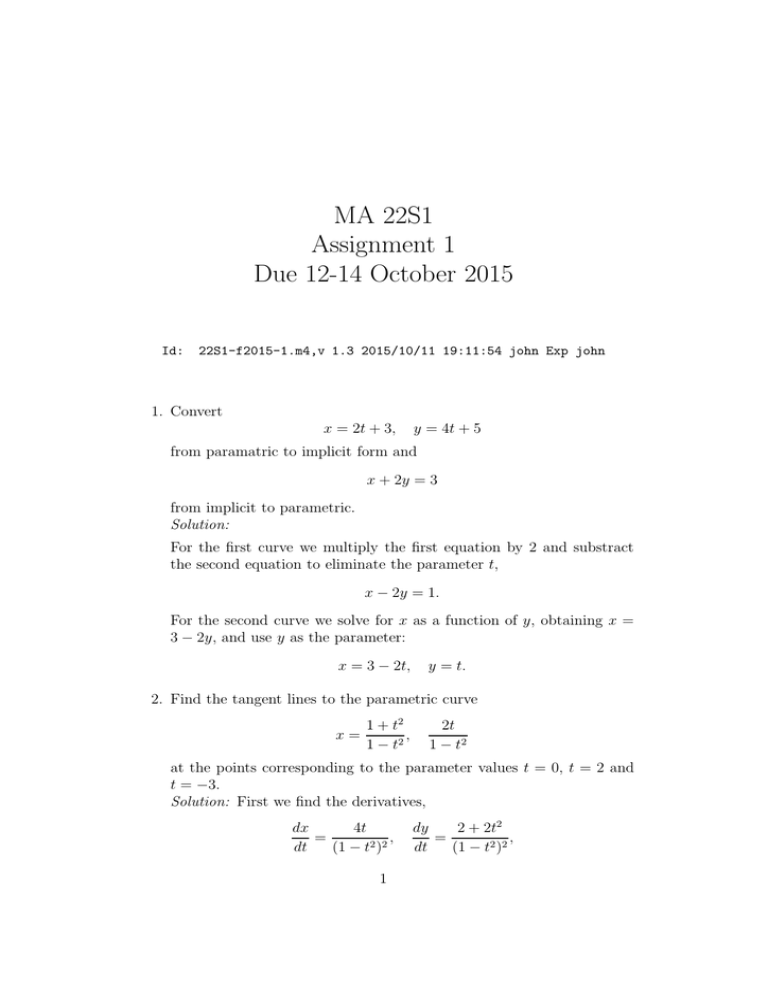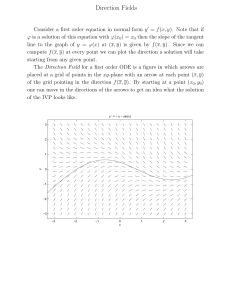MA 22S1 Assignment 1 Due 12-14 October 2015
advertisement

MA 22S1 Assignment 1 Due 12-14 October 2015 Id: 22S1-f2015-1.m4,v 1.3 2015/10/11 19:11:54 john Exp john 1. Convert x = 2t + 3, y = 4t + 5 from paramatric to implicit form and x + 2y = 3 from implicit to parametric. Solution: For the first curve we multiply the first equation by 2 and substract the second equation to eliminate the parameter t, x − 2y = 1. For the second curve we solve for x as a function of y, obtaining x = 3 − 2y, and use y as the parameter: x = 3 − 2t, y = t. 2. Find the tangent lines to the parametric curve x= 1 + t2 , 1 − t2 2t 1 − t2 at the points corresponding to the parameter values t = 0, t = 2 and t = −3. Solution: First we find the derivatives, dx 4t = , dt (1 − t2 )2 1 dy 2 + 2t2 = , dt (1 − t2 )2 Id: 22S1-f2015-1.m4,v 1.3 2015/10/11 19:11:54 john Exp john 2 and then their quotient m= dy/dt 1 + t2 = . dx/dt 2t This is the slope of the tangent line at the point with parameter value t, except in the exceptional case where the denominator is zero. For t = 0 the point is (1, 0) and the tangent is vertical, since dx/dt = 0 and dy/dt 6= 0, so the tangent line is x = 1. For t = 2 the point is (−5/3, −4/3) and the tangent line has slope m = 5/4, so the line is 5 y + 4/3 = 4 x + 5/3 or 15x − 12y + 9 = 0. For t = 3 the point is (−5/4, 3/4) and the tangent line has slope m = −5/3, so the line is y − 3/4 5 − = 3 x + 5/4 or 10x + 6y + 8 = 0. 3. Find the length of the parametric curve x= 1 + t2 , 1 − t2 y= 2t , 1 − t2 1 1 − <t< . 2 2 Note: the integral you get is not one with elementary indefinite integral, so you can’t get a closed form solution. So just simplify the integrand as much as you can, and leave it unintegrated, as in the last arc length example I did in lecture. Solution: The derivatives are still dx 4t = , dt (1 − t2 )2 dy 2 + 2t2 = , dt (1 − t2 )2 Then dx dt !2 dy + dt !2 = 4(t4 + 6t2 + 1) (4t)2 + (2 + 2t2 )2 = , (1 − t2 )4 (1 − t2 )4 Id: 22S1-f2015-1.m4,v 1.3 2015/10/11 19:11:54 john Exp john 3 and v u u t dx dt !2 L= dy + dt Z 1/2 2 −1/2 !2 √ =2 √ t4 + 6t2 + 1 (1 − t2 )2 t4 + 6t2 + 1 dt. (1 − t2 )2 4. Convert r 4 sin2 (2θ) = 4 from polar to Cartesian coordinates and 1 1 y = x2 − 2 2 from Cartesian to polar coordinates. Solution: For the first curve we use the angle addition formula sin(2θ) = 2 sin θ cos θ to get 4r 4 sin2 θ cos2 θ = 4 Then, because x = r cos θ, y = r sin θ, 4x2 y 2 = 4, or, more simply, x2 y 2 = 1. For the second curve we use again the equations x = r cos θ, y = r sin θ to get 1 1 r sin θ = r 2 cos2 θ − . 2 2 In principle this is already a correct answer, but it can be simplified somewhat. 1 1 1 r sin θ = r 2 − r 2 sin2 θ − 2 2 2 1 1 2 1 2 2 r sin θ + r sin θ + = r 2 2 2 2 2 r sin θ + 2r sin θ + 1 = r 2 , (r sin θ + 1)2 = r 2 , r sin θ + 1 = r. The last step might look dodgy. How do we know to take the positive square root? Well, r ≥ 0 by definition and r sin θ ≥ −r because sin θ ≥ −1. But then r sin θ + 1 > −r, so we can’t have r sin θ + 1 = −r.




